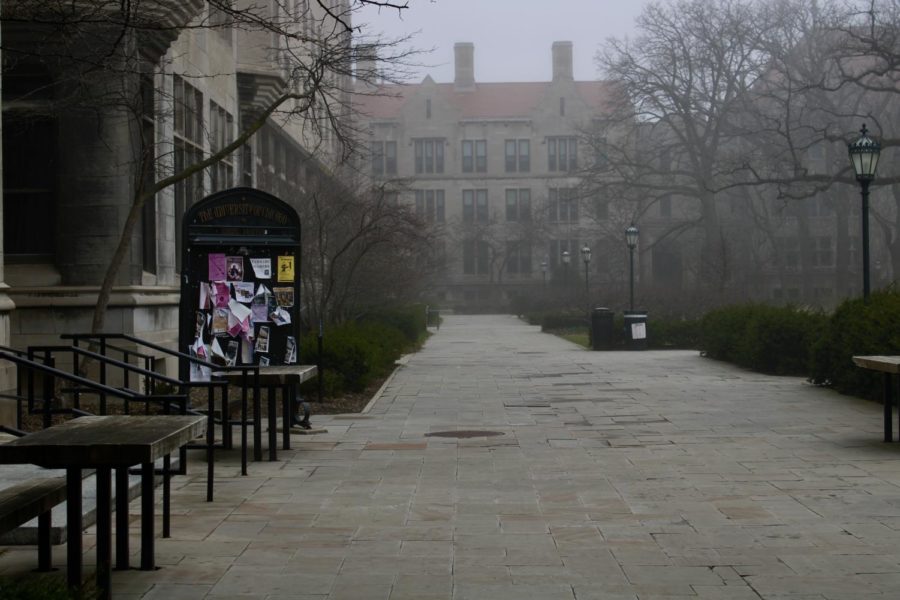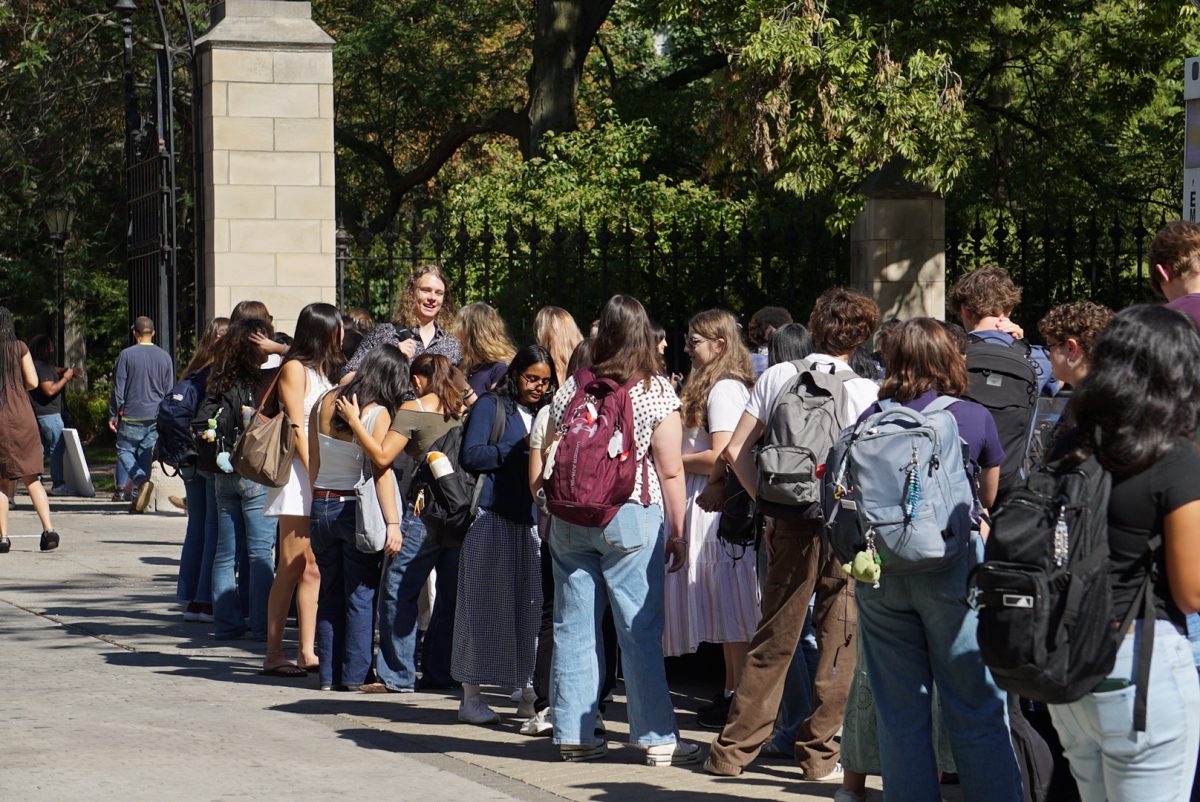Winter 2022 brought a series of changes to COVID-19 policies. Upon the return to campus, the University established a class-wide exposure protocol system and reinstituted mandatory surveillance testing. Then, halfway through the quarter, the class-wide notifications stopped. On February 28, mandatory testing stopped, and finally, as of March 4, mask mandates outside of classroom settings were revoked.
The Maroon took a look back at how exposure notifications were handled throughout the quarter, as well as some of the concerns about and ambiguities within the policies.
Individuals who may have been exposed to COVID-19 receive notification emails that include exposure recommendations; the email tells boosted individuals to get tested after five days and to wear a mask indoors until they test negative. Students have struggled to understand what these protocols mean in practice, leading to confusion around testing, dining, and enforcement.
From January 21 to February 3, overlapping with winter quarter’s first two weeks of in-person instruction, the University reported a total of 550 cases and 470 close contacts. From November 26 to December 9, the last two weeks of fall quarter, there were 115 new cases and 618 close contacts. However, COVID-19 cases and exposures, along with associated risks and protocols, have affected hundreds more students and instructors.
For the first three weeks of in-person instruction, class sections received mass exposure notifications when one participant tested positive. A University spokesperson clarified that during this period, the contact tracing team only sent exposure notifications to entire groups when the individual who tested positive did not recall specific close contacts in that setting.
The Maroon confirmed that in the first two weeks of in-person classes, students and instructors received exposure notification emails from at least 10 distinct class sections with a combined enrollment of more than 1,200. The largest class sections included Principles of Macroeconomics with 215 students, Principles of Microeconomics with 188 students, Fundamentals of Ecology and Evolutionary Biology with 196 students, and Organic Chemistry with 159 students.
Exposure Notifications
Prior to February 14, when someone in a class section had COVID-19, the entire section received an email from Jay Ellison, the dean of students in the College, warning students that they may have been exposed to COVID-19. The email included the class section, date of exposure, and relevant protocols.
The University’s exposure protocols are split into three sections. While recommendation A applies to those who have been boosted or recently vaccinated, recommendations B and C apply to the unvaccinated or un-boosted. As the class-wide email included full instructions for all three recommendations, it was more than 750 words long.
Recommendation A, for example, applies to all students and employees who did not receive an exemption from the University’s booster requirement. It asks that individuals get tested five days after their exposure and advises them to wear a mask in “indoor public settings” until they have received a negative test.
The email did not mention if weekly surveillance tests, which were mandatory at the time for students living on campus, counted as exposure tests, or whether students must avoid dining halls during the five-day masking period.
The class-wide email’s language also did not indicate that testing was a requirement. “If you do not get tested, you must wear a mask in public indoor settings for 10 days, beginning the day after your last exposure,” the email said.
After February 14, however, only individuals specifically named as close contacts received an exposure notification. This email, sent by a contact tracer, is shorter than the original class-wide notification, and it only includes the specific recommendation pertaining to the recipient’s vaccination status.
The exposure recommendation does not ask boosted individuals to take any further measures apart from masking, such as quarantining.
Enforcement & Communication of Protocols
The University does not send reminders of or enforce these exposure protocols. All five students interviewed by The Maroon for this story said that there had been no follow-up communications after their exposure notifications.
According to a University spokesperson, “Students are expected to follow all COVID-19 health requirements; serious violations can result in disciplinary action.” They did not respond to follow-up questions about whether there had been any instances of such disciplinary action.
The protocols also ask unvaccinated or un-boosted individuals to self-report their exposure status to c19healthreport@uchicago.edu. All individuals are asked to self-report if they receive a positive test.
In effect, exposed individuals each decide whether and how to follow the exposure protocols. Students in particular often weigh abiding by the protocols against keeping up with their academics.
Third-year Gabi Garcia noticed that some students seem to prioritize their academics over COVID-19 best practices, for instance by attending classes in person despite having symptoms. “Despite the fact that a lot of my professors are being really great about [accommodations]…people are still showing up to classes,” Garcia said. “I feel like it's a reflection of this University and the culture that it tends to create around work.”
While discussing classes offering no makeup or remote exams, second-year Ali Sait said that students may actively avoid COVID-19 testing in the event that being placed in isolation would negatively impact their grades. “It's so clear that the current policy will force students to not get tested or come to class if they have symptoms,” Sait said.
However, even individuals committed to following the protocols expressed confusion on what specific actions the recommendations entailed.
Testing
One point of confusion was whether exposed students enrolled in the weekly surveillance testing program were required to schedule a separate exposure test. When surveillance testing was still in place, the University clarified via their spokesperson: “A surveillance test would suffice if it is at least five days after exposure.” Students were left on their own to decide whether to schedule a separate test.
In the first two weeks of in-person classes, third-year Michelle Yang received three exposure notifications across two classes. She said that her first two exposure dates lined up with her weekly surveillance test schedule but that she decided to schedule a separate exposure test upon receiving the last of those notifications.
Meanwhile, Sait noted that he had received his notification four days after the exposure date; his weekly test schedule had coincidentally lined up with the exposure testing timeline, but because of the delay of the notification, he hadn’t been able to respond until almost five days had already elapsed.
The recommendations sent in class-wide notifications also included options for students who do not get tested, implying that testing was not a requirement. However, the University clarified that testing was expected and that non-testing options had been included only to accommodate individuals who would face difficulty getting tested. When class-wide notifications were still in place, a spokesperson said, “While everyone is expected to follow testing and other requirements in the exposure protocol, in some cases this may not be possible, for example when a student is notified while they are traveling.”
According to the recommendations, people up to date on vaccinations who do not get tested should mask indoors for 10 days; people not up to date on vaccines who do not get tested should quarantine for 10 days.
Dining
The masking requirement in the recommendations also raised questions about whether exposed students may continue to eat inside the dining halls, which inherently requires unmasking.
The University’s exposure protocol includes the following note: “If an individual is unable to wear a face covering around others, the individual should continue to isolate or quarantine for a full 10 days, as applicable, and should not go to places where the individual would be unable to wear a face covering (e.g., restaurants, gyms, eating around others, etc.).”
However, the University spokesperson clarified that students up to date on vaccinations can continue to use dining halls during the five days after exposure. Such students only have to isolate and avoid the dining halls if they test positive. Exposed students who are not up to date on vaccinations must quarantine, and therefore not use the dining halls, until they test negative after day five.
Multiple students said that they continued to eat in dining halls after receiving an exposure notification.
Meanwhile, Garcia highlighted the challenge of limited to-go meal swipes. UChicago Dining’s takeout limits are that students may use 50 to-go swipes per quarter and only one per meal period.
Garcia said that in the fall, for a period when she had recently been exposed and thought she likely had COVID-19, she took her dining hall meals as takeout. Garcia recalled that one day, when she took out a late lunch around 3 p.m., which falls in the transition period between lunch and dinner, she was not allowed to take out another meal at dinner because she had already used her one meal swipe for the meal period.
Garcia hoped for more flexibility in the takeout system so that she could avoid endangering her peers without skipping meals. “The fact that there's a cap on takeout dining right now is absurd,” she said. “During the exposure, my schedule got quite messy, and so I frequently had to skip meals because I couldn't use takeout swipes, which is not healthy.”
When asked about the limit on takeout swipes, the University spokesperson said: “UChicago Dining continues to monitor the use of ‘to-go’ meals and will evaluate any changes based on the utilization of the 50 to-go meals currently offered. At this point the overall utilization is significantly less than the 50 meals offered as part of the meal plan and no increase is warranted.”
The spokesperson did not immediately respond to requests for clarification on the policy of one swipe per meal period.









